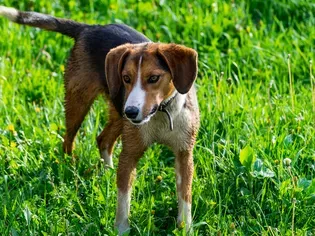Harrier: Dog Breed Characteristics & Care
Updated on 05/26/24

Unveiling the Harrier: An Enduring Legacy of Versatility and Devotion
Introduction
Throughout centuries of companionship, the Harrier has etched its name in the annals of canine history as a breed of unparalleled versatility and unwavering loyalty. From its origins as a skilled hunter to its modern-day role as a cherished family companion, the Harrier exudes an enduring charm that captivates hearts.
Origins and History
The Harrier traces its lineage back to the Middle Ages, where it played a pivotal role in the hunting expeditions of English nobility. Its ancestry can be traced to the Southern Hound, a breed renowned for its exceptional speed and stamina. Through selective breeding, the Harrier was developed specifically for its ability to pursue and tree prey, particularly rabbits and foxes.
Physical Characteristics
The Harrier is a medium to large-sized dog with a well-balanced and athletic build. Its body is slightly longer than it is tall, with a muscular frame and strong legs. The Harrier's height typically ranges from 19 to 21 inches at the shoulder, while its weight can vary from 40 to 60 pounds.
Its head is long and lean, with a pronounced but not overly wide muzzle. The eyes are dark and almond-shaped, conveying an expression of intelligence and alertness. The ears are set high on the head and hang down in a graceful V-shape.
The Harrier's coat is short and smooth, with a dense undercoat that provides insulation against harsh weather conditions. The coat comes in a variety of colors and patterns, including black, tan, white, tricolor, and bluetick.
Temperament and Personality
The Harrier is known for its friendly and affectionate nature. It is a devoted companion that thrives on human interaction and enjoys spending time with its family. Harriers are highly intelligent and eager to please, making them responsive to training.
Despite their gentle demeanor, Harriers retain their hunting instincts and can be quite independent at times. They are curious and enjoy exploring their surroundings, so it is important to provide them with ample opportunities for exercise and mental stimulation.
Care and Health
The Harrier is a relatively low-maintenance breed in terms of grooming. Regular brushing will help to keep its coat clean and healthy, and occasional baths may be necessary. Trimming the nails and cleaning the ears are also essential aspects of basic care.
Harriers are generally healthy dogs with an average lifespan of 10 to 12 years. However, like all breeds, they are prone to certain health conditions, including hip dysplasia, elbow dysplasia, and thyroid issues. Regular veterinary checkups and proper nutrition are key to maintaining their well-being.
Training and Exercise
Harriers are intelligent and eager to learn, making them responsive to training. Positive reinforcement and consistent techniques are recommended to establish a strong bond and train them effectively.
Exercise is essential for the health and well-being of Harriers. They require at least an hour of vigorous exercise each day, which can include walks, runs, or playtime in a fenced-in area. Harriers also enjoy interactive games that stimulate their hunting instincts, such as fetch and hide-and-seek.
Examples of Harrier Versatility
Hunting Companion: Harriers continue to excel in their traditional role as hunting dogs, particularly in hare coursing and rabbit hunting. Their keen sense of smell, speed, and stamina make them formidable trackers.
Family Pet: Harriers make exceptional family pets, providing companionship, affection, and entertainment. They are gentle with children and adore being part of a loving home environment.
Therapy Dog: Harriers' friendly and compassionate nature makes them well-suited for therapeutic roles, bringing joy and comfort to people in hospitals, nursing homes, and other settings.
Agility and Obedience: Harriers excel in agility and obedience competitions, showcasing their intelligence and athleticism. They enjoy the challenges and thrive on the positive reinforcement they receive from their handlers.
Lifestyle and Compatibility
Harriers are adaptable dogs that can thrive in a variety of living environments. They are well-suited for active families who can provide them with ample exercise and mental stimulation. However, it is important to remember that Harriers are scent hounds and can be easily distracted by interesting odors, so a fenced-in yard or a leash is essential when they are not in a secure area.
Conclusion
The Harrier is a breed of captivating versatility and unwavering devotion. From its hunting origins to its modern-day roles as a cherished family companion and therapeutic partner, the Harrier has proven its enduring worth throughout history. Its intelligence, adaptability, and friendly nature make it an ideal companion for those seeking a loyal, active, and affectionate addition to their lives.
Explore More Pets

Basic Training
Puppy and Baby Introductions

Working Dog Breeds
All About Search and Rescue Dogs

Dog Treatments
Puppy Vaginitis: Signs, Causes and Treatment

Dog Adoption
After More Than 1,200 Days in the Shelter, Coco Goes Home

Basic Training
How to Train Your Puppy to Go on Potty Pads

Hybrid Dog Breeds
The Difference Between a Mutt, Mixed Breed, or Designer Dog?

Dog Treatments
Nail Problems in Dogs

Puppies
7 Reasons Why Two Dogs Are Better Than One
